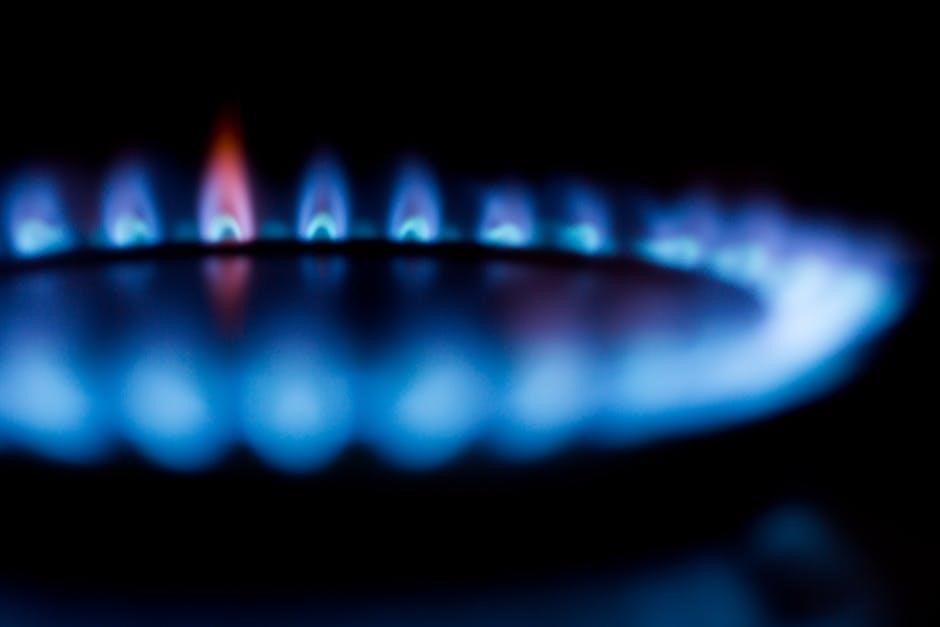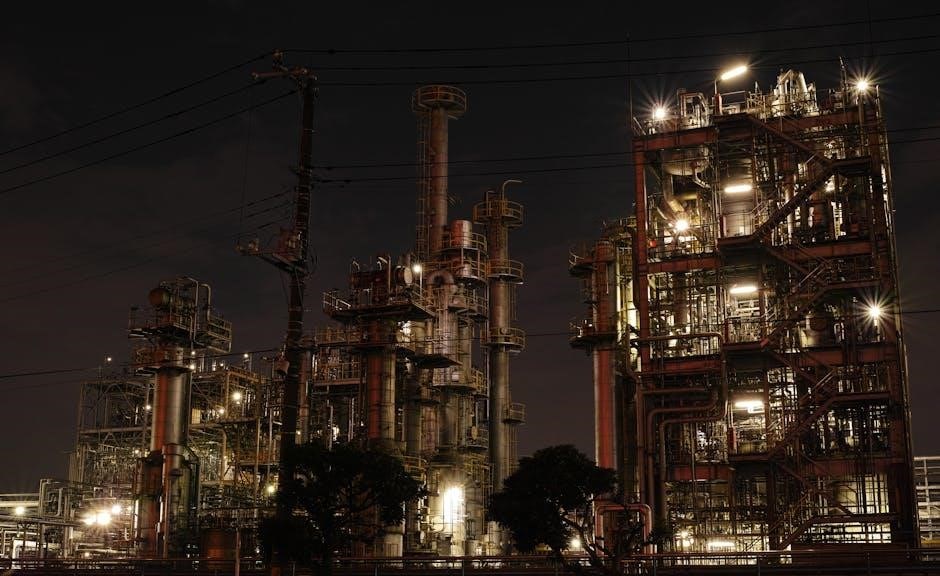Gas laws describe how gases behave under various conditions. Worksheets provide practical problems to solve, covering Boyle’s, Charles’s, and Ideal Gas Laws, enhancing understanding and application skills.
1.1 Overview of Gas Laws
Gas laws are fundamental principles that describe the behavior of gases under various conditions of pressure, volume, and temperature. They include Boyle’s, Charles’s, and Gay-Lussac’s Laws, which were later unified into the Combined Gas Law. These laws help predict how gases respond to changes in their environment. Worksheets on gas laws provide structured problems to apply these principles, ensuring a deep understanding of gas behavior. They cover calculations involving volume, pressure, and temperature changes, making them essential tools for chemistry students to master these concepts effectively.
1.2 Importance of Gas Laws in Chemistry
Gas laws are essential for understanding the behavior of gases, which is critical in chemistry and related fields; They provide the foundation for predicting how gases respond to changes in pressure, volume, and temperature. These principles are applied in various industrial processes, respiratory medicine, and scuba diving. Mastering gas laws enhances problem-solving skills and is vital for chemists and engineers. Worksheets with answers offer practical exercises to apply these laws, ensuring a strong grasp of their real-world applications and theoretical significance.

Boyle’s Law
Boyle’s Law states that the volume of a gas is inversely proportional to its pressure at constant temperature. This fundamental principle helps predict volume changes under varying pressures, making it essential for solving gas law problems in chemistry and physics.
2.1 Definition and Statement of Boyle’s Law
Boyle’s Law states that the volume of a gas is inversely proportional to its pressure when temperature remains constant. This means that as pressure increases, volume decreases, and vice versa. Mathematically, it is expressed as ( P_1V_1 = P_2V_2 ), where ( P ) represents pressure and ( V ) represents volume. This law applies to ideal gases and provides a foundational understanding of gas behavior under varying conditions. It is a crucial principle in chemistry and physics, enabling predictions of volume changes when pressure is altered.
2.2 Formula for Boyle’s Law (P1V1 = P2V2)
The formula for Boyle’s Law is ( P_1V_1 = P_2V_2 ), where ( P_1 ) and ( P_2 ) are initial and final pressures, and ( V_1 ) and ( V_2 ) are initial and final volumes. This equation shows that the product of pressure and volume remains constant for a given mass of gas at constant temperature. Worksheets often use this formula to solve problems involving pressure-volume relationships, reinforcing the inverse proportionality between pressure and volume.
2.3 Graphical Representation of Boyle’s Law
A graphical representation of Boyle’s Law shows the relationship between pressure and volume. When temperature is constant, plotting pressure (P) against volume (V) results in a hyperbola. Similarly, plotting pressure against the reciprocal of volume (1/V) yields a straight line. These graphs visually reinforce the inverse relationship between pressure and volume. Worksheets often include such plots to help students analyze and solve problems involving Boyle’s Law, providing a clear visual aid for understanding the law’s principles and applications.
2.4 Solved Examples Using Boyle’s Law
Solved examples using Boyle’s Law demonstrate its application in calculating pressure or volume changes. For instance, if a gas occupies 12 L at 2 atm, its volume at 3 atm is 8 L. Similarly, if 5 L of gas at 4 atm is expanded to 10 L, the pressure drops to 2 atm. Worksheets provide such problems, guiding students to apply the formula ( P_1V_1 = P_2V_2 ) and understand the inverse relationship between pressure and volume at constant temperature.

Charles’s Law
Charles’s Law states that the volume of a gas varies directly with its temperature in Kelvin at constant pressure. Worksheets provide problems applying V1/T1 = V2/T2.
3.1 Definition and Statement of Charles’s Law
Charles’s Law defines the direct relationship between the volume and temperature of a gas at constant pressure. Discovered by Jacques Charles, it states that as temperature increases, volume proportionally rises when pressure remains unchanged. This fundamental principle is mathematically expressed as V1/T1 = V2/T2, where V represents volume and T represents temperature in Kelvin. Worksheets often include problems applying this law to real-world scenarios, helping students grasp its practical implications in chemistry and physics.
3.2 Formula for Charles’s Law (V1/T1 = V2/T2)
The formula V1/T1 = V2/T2 encapsulates Charles’s Law, where V represents volume and T represents temperature in Kelvin. This equation shows a direct proportional relationship between volume and temperature when pressure is constant. It allows calculation of either volume or temperature when the other is known. Worksheets often include problems that apply this formula to various scenarios, such as determining the volume at a different temperature or finding the temperature corresponding to a new volume, ensuring practical mastery of the concept.
3.3 Graphical Representation of Charles’s Law
A graphical representation of Charles’s Law plots volume (V) against temperature (T) at constant pressure. The graph is a straight line passing through the origin, demonstrating a direct relationship. This visual tool helps students understand that as temperature increases, volume proportionally increases, and vice versa. Worksheets often include such graphs to illustrate the law, making it easier to solve problems by identifying unknown variables. The graphical approach reinforces the concept of direct proportionality, aiding in both theoretical understanding and practical application of Charles’s Law.
3.4 Solved Examples Using Charles’s Law
Example 1: A gas occupies 5.0 L at 300 K. If the temperature increases to 350 K, what is the new volume? Using V1/T1 = V2/T2, solve for V2: V2 = (5.0 L * 350 K) / 300 K = 5.83 L.
Example 2: If a balloon inflates to 8.0 L at 295 K, what volume will it occupy at 395 K? V2 = (8.0 L * 395 K) / 295 K ≈ 8.68 L.
These examples demonstrate how Charles’s Law is applied to find unknown volumes or temperatures, enhancing problem-solving skills in gas behavior analysis.

Gay-Lussac’s Law
Gay-Lussac’s Law relates pressure and temperature changes in gases at constant volume. It states P1/T1 = P2/T2, aiding in calculating pressure or temperature variations for practical problems.
4.1 Definition and Statement of Gay-Lussac’s Law
Gay-Lussac’s Law states that the pressure of a gas is directly proportional to its temperature when volume is constant. Mathematically, it is expressed as P₁/T₁ = P₂/T₂, where P and T represent pressure and temperature, respectively. This law is essential for understanding how temperature changes affect gas pressure in various applications, such as industrial processes and respiratory systems. Worksheets often include problems that apply this law to real-world scenarios, helping students master its practical implications through guided exercises and solutions.
4.2 Formula for Gay-Lussac’s Law (P1/T1 = P2/T2)
4.2 Formula for Gay-Lussac’s Law (P₁/T₁ = P₂/T₂)
The formula P₁/T₁ = P₂/T₂ mathematically represents Gay-Lussac’s Law, where P is pressure and T is temperature in Kelvin. This equation shows that the ratio of pressure to temperature remains constant when volume and the number of moles of gas are held constant. It is widely used to calculate pressure changes due to temperature variations in industrial processes and scuba diving applications. Worksheets often include problems that apply this formula to real-world scenarios, providing practical exercises for mastering its use. This law is fundamental for understanding gas behavior under varying conditions.
4.3 Solved Examples Using Gay-Lussac’s Law
Example 1: A gas at 2.5 atm and 300 K is heated to 450 K. Using P₁/T₁ = P₂/T₂, calculate the new pressure.
- Given: P₁ = 2.5 atm, T₁ = 300 K, T₂ = 450 K.
- Unknown: P₂.
- Solve: P₂ = (P₁ × T₂) / T₁ = (2.5 × 450) / 300 = 3.75 atm.
Example 2: A gas at 1.8 atm and 250 K is cooled to 150 K. Calculate the new pressure.
- Given: P₁ = 1.8 atm, T₁ = 250 K, T₂ = 150 K.
- Unknown: P₂.
- Solve: P₂ = (P₁ × T₂) / T₁ = (1.8 × 150) / 250 = 1.08 atm.
These examples demonstrate how Gay-Lussac’s Law is applied to find pressure changes at constant volume, essential for industrial and real-world applications.

Combined Gas Law
The Combined Gas Law relates pressure, volume, and temperature changes of a gas, combining Boyle’s, Charles’s, and Gay-Lussac’s Laws into one formula: P₁V₁/T₁ = P₂V₂/T₂.
5.1 Definition and Statement of Combined Gas Law
The Combined Gas Law integrates Boyle’s, Charles’s, and Gay-Lussac’s Laws, describing how pressure, volume, and temperature of a gas change simultaneously. It states that P₁V₁/T₁ = P₂V₂/T₂, where (P), (V), and (T) represent pressure, volume, and temperature, respectively. This law applies when the number of moles of gas remains constant. It is particularly useful for solving problems involving changes in two or more gas properties, providing a single equation to relate these variables. Worksheets often include problems that apply this law to real-world scenarios, enhancing problem-solving skills.
5.2 Formula for Combined Gas Law (P1V1/T1 = P2V2/T2)
The Combined Gas Law is expressed as P₁V₁/T₁ = P₂V₂/T₂, where P represents pressure, V represents volume, and T represents temperature. This formula shows the relationship between these properties when the number of moles of gas remains constant. It allows for the calculation of one unknown variable when the other three are known. Worksheets often include problems that require rearranging this formula to solve for specific variables, such as pressure, volume, or temperature, under different conditions.
5.3 Solved Examples Using Combined Gas Law
Worksheets often include problems like: “A gas occupies 12.5 L at 2.5 atm and 300 K. What is its volume if the pressure changes to 3.0 atm and the temperature rises to 350 K?” Using the formula P₁V₁/T₁ = P₂V₂/T₂, rearrange to solve for V₂: V₂ = (P₁/P₂) * (T₂/T₁) * V₁. Plugging in the values: V₂ = (2.5/3.0) * (350/300) * 12.5 = 14.58 L. Such examples help students master the application of the Combined Gas Law in diverse scenarios, ensuring accurate and efficient problem-solving.

Ideal Gas Law
The Ideal Gas Law, PV = nRT, relates pressure, volume, moles, and temperature of a gas. Worksheets provide problems to solve for missing variables, enhancing understanding and application.
6.1 Definition and Statement of Ideal Gas Law
The Ideal Gas Law, defined by the equation PV = nRT, describes the relationship between pressure (P), volume (V), moles (n), and temperature (T) of a gas. It assumes ideal behavior, meaning no intermolecular forces or particle volume. This law is widely used to solve problems involving changes in gas properties and is foundational in chemistry and physics. Worksheets often include problems requiring the application of this law to find unknown variables, such as pressure, volume, or temperature, under various conditions.
6.2 Formula for Ideal Gas Law (PV = nRT)
The formula PV = nRT is central to the Ideal Gas Law, where P is pressure in atmospheres, V is volume in liters, n is moles of gas, R is the universal gas constant (0.0821 L·atm/mol·K), and T is temperature in Kelvin. This equation allows calculation of any single variable when the others are known, making it a versatile tool for solving gas-related problems. Worksheets often include exercises that apply this formula to real-world scenarios, ensuring mastery of gas behavior under varying conditions.
6.3 Universal Gas Constant (R)
The universal gas constant R is a fundamental value in the Ideal Gas Law, with a value of 0.0821 L·atm/mol·K. This constant allows the law to be applied universally, relating pressure, volume, temperature, and moles of gas. Worksheets often emphasize using R correctly, ensuring unit consistency. For example, when pressure is in atmospheres and volume in liters, R remains constant, enabling accurate calculations of unknown variables like pressure, volume, or temperature. Its consistency across units makes it indispensable for solving gas-related problems in various scenarios.
6.4 Solved Examples Using Ideal Gas Law
Solved examples using the Ideal Gas Law demonstrate its practical application. For instance, calculating the moles of air in lungs at 3.9 L, 1 atm, and 298 K yields 0.16 moles. Another example determines the temperature of a gas when pressure, volume, and moles are known. Worksheets provide step-by-step solutions, emphasizing unit consistency and significant figures. These problems enhance understanding of how PV = nRT relates gas properties, making complex calculations manageable and reinforcing theoretical concepts through real-world applications.
Gas Laws Worksheet
A gas laws worksheet provides structured problems covering Boyle’s, Charles’s, and Ideal Gas Laws. It includes solved examples and practical applications, enhancing problem-solving skills and understanding.
7.1 Types of Problems in Gas Laws Worksheet
Gas laws worksheets include various problem types, such as calculating moles of gas, volume changes, pressure variations, and temperature adjustments. Problems may involve single or combined gas laws, requiring conversions between units like atm, mmHg, and K. Examples include determining gas volume at STP, mole calculations using PV = nRT, and mixed problems combining Boyle’s, Charles’s, and Gay-Lussac’s laws. Worksheets also cover practical applications, ensuring proficiency in applying theoretical concepts to real-world scenarios with precision and accuracy.
7.2 Importance of Practicing Gas Laws Worksheet
Practicing gas laws worksheets enhances problem-solving skills and deepens understanding of gas behavior. Regular practice helps master calculations involving pressure, volume, temperature, and moles. It improves unit conversion accuracy, significant figure management, and ability to identify the correct law for each scenario. Worksheets also build confidence in applying theoretical concepts to real-world problems, such as respiratory systems or industrial processes, ensuring readiness for advanced chemistry topics and standardized tests.

Common Problems in Gas Laws
Common problems include calculating volume, pressure, and temperature changes, as well as determining moles of gas under various conditions, ensuring accurate unit conversions and significant figure handling.
8.1 Calculating Volume Changes
Calculating volume changes involves applying gas laws like Boyle’s and Charles’s Laws. For instance, using Boyle’s Law (P1V1 = P2V2), one can determine the new volume when pressure changes at constant temperature. Similarly, Charles’s Law (V1/T1 = V2/T2) helps find volume changes with temperature variations at constant pressure. Worksheets often provide scenarios where these laws are applied to solve for unknown volumes, ensuring students understand the inverse and direct relationships between variables. These problems enhance problem-solving skills and conceptual understanding of gas behavior under different conditions.
8.2 Calculating Pressure Changes
Calculating pressure changes involves using Gay-Lussac’s Law (P1/T1 = P2/T2) or the Combined Gas Law. For example, if a gas balloon has a volume of 106.0 L at 45.0°C and 740.0 mm Hg, and the temperature changes, the new pressure can be calculated. Worksheets provide problems where pressure must be determined under varying conditions, ensuring accurate unit conversions and significant figure management. These exercises help students master pressure calculations in real-world scenarios, avoiding common errors like incorrect unit conversions.
8.3 Calculating Temperature Changes
Calculating temperature changes typically involves Charles’s Law (V1/T1 = V2/T2) or the Combined Gas Law (P1V1/T1 = P2V2/T2). For instance, if 6.00 L of gas at 20.0°C is compressed to 4.00 L, the temperature decrease can be determined. Worksheets provide such problems, emphasizing unit conversions (e.g., Celsius to Kelvin) and significant figure accuracy. These exercises help students understand how temperature relates to volume and pressure, ensuring precise calculations in various scenarios.
8.4 Calculating Moles of Gas
Calculating moles of gas often involves the Ideal Gas Law (PV = nRT). For example, determining moles of gas in a lung with a capacity of 3.9 L at specific conditions. Worksheets provide problems like finding moles in 98 L at 2.8 atm and 292 K; Solutions require converting units (e.g., Kelvin for temperature) and applying the gas constant R (0.0821 L·atm/mol·K). These exercises enhance understanding of gas properties and their quantitative relationships in various scenarios.

Solving Gas Law Problems
Solving gas law problems involves identifying given values, selecting the appropriate law, and performing calculations. Worksheets provide structured exercises to strengthen problem-solving skills and understanding.
9.1 Identifying Given and Unknown Values
Identifying given and unknown values is the first step in solving gas law problems. Worksheets often provide data such as pressure, volume, temperature, or moles of gas. For example, a problem might give initial pressure (P1), initial volume (V1), and final pressure (P2), asking for the final volume (V2). It’s crucial to list all known values and circle the unknown variable. This clarity helps in selecting the appropriate gas law to apply, such as Boyle’s or Charles’s Law. Always check units and convert if necessary to ensure consistency.
- Underline or highlight known values.
- Circle the unknown variable to focus on what needs to be found.
- Ensure units are consistent (e.g., Kelvin for temperature, atmospheres for pressure).
Practicing this step improves problem-solving efficiency and reduces errors.
9.2 Selecting the Appropriate Gas Law
Selecting the right gas law depends on the variables provided. If volume and pressure change with constant temperature, use Boyle’s Law. For volume and temperature changes at constant pressure, Charles’s Law applies. Gay-Lussac’s Law is used when pressure and temperature change. The Combined Gas Law covers scenarios with two changing variables, while the Ideal Gas Law is ideal when moles, pressure, volume, or temperature are involved. Always match the law to the given variables for accurate solutions.
- Boyle’s Law: P1V1 = P2V2 (constant T)
- Charles’s Law: V1/T1 = V2/T2 (constant P)
- Gay-Lussac’s Law: P1/T1 = P2/T2 (constant V)
- Combined Gas Law: P1V1/T1 = P2V2/T2
- Ideal Gas Law: PV = nRT
Choosing the correct law simplifies calculations and ensures accurate results. Always confirm units are consistent before applying the formula.
9.3 Performing Calculations
Performing accurate calculations involves identifying known and unknown variables, selecting the correct gas law, and ensuring consistent units. Start by rearranging the formula to solve for the unknown value. Plug in the known values and calculate step-by-step. For example, using Boyle’s Law (P1V1 = P2V2), solve for P2 by dividing P1V1 by V2. Always double-check unit conversions and significant figures to ensure precision. Practice problems in worksheets help refine these skills, making complex calculations more manageable over time.
- Identify known and unknown variables.
- Rearrange the formula to solve for the unknown.
- Plug in values and calculate step-by-step.
- Ensure unit consistency and check significant figures.
Attention to detail is critical for accurate results in gas law calculations.
9.4 Checking Significant Figures
Checking significant figures ensures the accuracy and reliability of calculations. Always match the number of significant figures in the final answer to the least precise measurement provided. For instance, if given values have three and four significant figures, the answer should have three. Rounding correctly is essential to maintain precision without overreporting. Worksheets often emphasize this step to train students in proper scientific notation and data presentation. This practice reinforces the importance of precision in experimental and theoretical chemistry applications.

Tips for Solving Gas Law Problems
Mastering gas law problems requires understanding relationships between pressure, volume, and temperature. Always identify given values, choose the appropriate law, and convert units when necessary for accurate solutions.
10.1 Understanding the Relationships
Understanding the relationships in gas laws is crucial for solving problems. Boyle’s Law links pressure and volume inversely, while Charles’s Law connects volume and temperature directly. Gay-Lussac’s Law relates pressure and temperature. The Combined Gas Law unites these variables, and the Ideal Gas Law incorporates moles. Recognizing these connections helps in selecting the right approach for each problem. Practicing with worksheets ensures familiarity with how pressure, volume, and temperature changes affect gases, improving problem-solving efficiency and accuracy in various scenarios.
10.2 Converting Units
Converting units is essential in gas law problems to ensure consistency. Common conversions include pressure from mmHg to atm, volume from liters to cubic meters, and temperature from °C to K. For example, 760 mmHg equals 1 atm, and 25°C is 298 K. Always verify units before calculations to avoid errors. Worksheets often provide conversion factors, aiding in accurate problem-solving. Proper unit conversion ensures that gas law relationships are applied correctly, leading to precise and reliable results in various scenarios;
10.3 Avoiding Common Mistakes
Common mistakes in gas law problems include incorrect unit conversions and forgetting to convert Celsius to Kelvin. Ensure all units match before applying formulas. Another error is misidentifying which variables are constant, leading to the wrong law being applied. Always check significant figures and ensure calculations are precise. Worksheets highlight these pitfalls, helping students recognize and avoid them. By being meticulous and methodical, learners can master gas law applications and achieve accurate results consistently.

Practical Applications of Gas Laws
Gas laws are crucial in respiratory systems, scuba diving, and industrial processes. They explain how gases behave under various conditions, aiding in medical and technological advancements.
11.1 Respiratory System
Gas laws are essential in understanding respiratory physiology. Boyle’s Law explains lung expansion and contraction, affecting breathing mechanics. Partial pressures of oxygen and carbon dioxide, governed by Dalton’s Law, regulate gas exchange in the lungs. This understanding is crucial for medical professionals to diagnose and treat respiratory disorders like asthma or COPD. Worksheets on gas laws help healthcare students grasp these principles, ensuring accurate oxygen therapy and ventilation management in clinical settings.
11.2 Scuba Diving
Scuba diving relies heavily on gas laws to ensure safety underwater. Boyle’s Law explains pressure changes affecting lung volume, crucial for avoiding barotrauma. The Ideal Gas Law helps calculate air supply duration at varying depths and pressures. Worksheets on gas laws enable divers to understand nitrogen absorption and decompression sickness risks. Proper application of these principles ensures safe ascent and prevents gas-related injuries, making gas law understanding vital for every diver to manage their environment effectively and avoid potential hazards during underwater explorations.
11.3 Industrial Processes
Gas laws are integral to industrial processes, influencing manufacturing, safety, and environmental practices. In chemical plants, the Ideal Gas Law optimizes reactions by predicting gas behavior under varying conditions. Compressed gas systems rely on Boyle’s Law to manage pressure-volume relationships, ensuring safe storage and transportation. Industrial safety protocols use Charles’s Law to anticipate thermal expansion risks, preventing accidents. Additionally, pollution control systems apply gas laws to calculate emissions and ensure compliance with regulations. These principles are essential for efficient, safe, and sustainable industrial operations across various sectors.
Gas laws are fundamental principles in chemistry, providing a framework to understand gas behavior under various conditions. Through worksheets and practical problems, students master concepts like Boyle’s, Charles’s, and the Ideal Gas Law. These exercises enhance problem-solving skills and apply to real-world scenarios, such as industrial processes and respiratory systems. By practicing with worksheets, learners gain confidence in calculating volume, pressure, temperature, and moles, essential for both academic success and practical applications in science and engineering.



